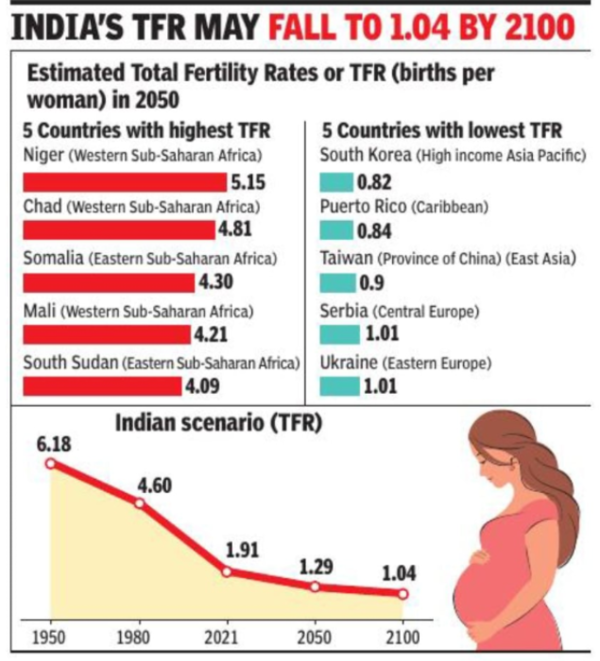A recent study from the Lancet stressed on the rising concern in India about the drop of fertility rate. The lancet made the prediction that, following the current trend, the fertility rate or TFR is likely to be 1.29 by 2050. The current report has been a concerning one considering the fact that in 1950 the fertility rate was 6.18 and then it was 4.6 by 1980. But in the year 2021, the rate collapsed to 1.91. This fell much below the expected size of population of 2.1 children each woman.
The Lancet predicts India’s population decline in the next decades. Nationwide demographic experts, who forecast serious challenges, are concerned. Due to population decline, society aged fast. There is a growing geriatric dependency on a diminishing working-age population. This imbalance might affect social security and healthcare. The labour force deficit is another concern. Companies may struggle to hire qualified critical employees as the pool of young workers shrinks. This may hinder economic growth and productivity.

The Lancet’s warning also raises concerns about social inequality. As fertility rates may drop disproportionately, India’s poor sex ratios may further deteriorate. However, son bias may reinforce this. Poonam Mutreja, PFI’s executive director, remarks, “We cannot afford to wait 20-30 years for demographic realities to set in. The government and society must ensure working to reduce the economic cost of having a child that they impose disproportionately on women. But abroad, Mutreja emphasizes the fact even more. Challenges over the future cannot be met through a lone ranger approach, but upon the need of a multi-pronged response. India isn’t alone in staring at this demographic storm. The Lancet uses the new age of demographic forecasting to estimate that by 2050, 76% of countries and territories (155 out of 204) will fall below replacement fertility. On the other hand, factors on which the current comprehensive study is premised include mortality, education, family planning, child mortality, and urbanization that impact population dynamics.
Mutreja depicts complex economic-social interactions. Childrearing costs more as economies develop. More expensive education, healthcare, and basic requirements lead families to plan for fewer children. Education and empowerment of women are transforming social dynamics. Ambitious women delay marriage and parenthood for work. The average number of children a woman has decreases due to this trend. Urbanization matters too. City contraception and family planning resources are easier to find. Social norms are also reducing family size. Mutreja argues these factors diminish India’s birthrate. Possible Indian population decline is tricky.

The Lancet projects that 97%, 198 of 204 countries and territories, will have below-replacement fertility by 2100. Global effort to combat plummeting fertility rates is needed. Governments, lawmakers, and international organizations must prioritize education, healthcare, and family planning to manage population transition. Women affect reproduction and societal progress, thus gender equality and empowerment are crucial. Declining fertility rates threaten inequality, sustainable development, and equitable prosperity without prompt action.
Overall, The Lancet both warns and forms a sobering reminder of the real time bomb in need of proactive measures to navigate demographic transitions occurring across the face of the earth. The future for the projected sustainable population increment and development along the line of equity might be paved through multifaceted effort that would touch economic, social, and cultural issues. Failure to listen to this warning will leave the coming generations living in a contemporary world with constant threat of demographic imbalances and societal inequities.
